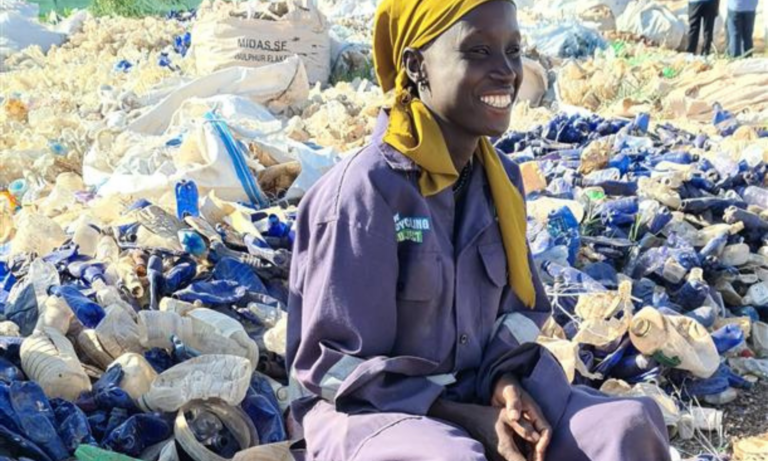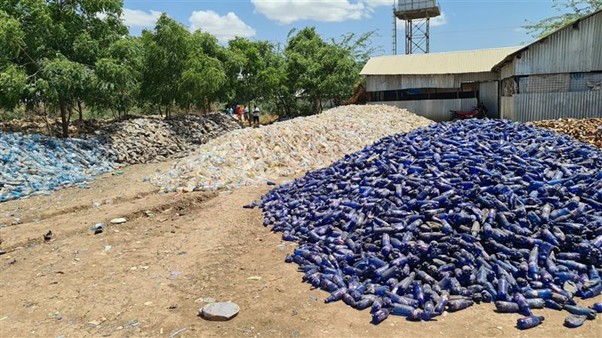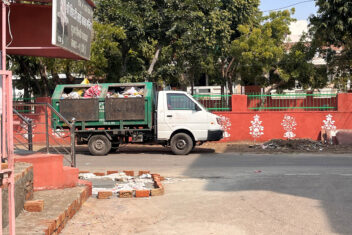Mapping the Solid Waste Management Landscape in Kakuma Refugee Camp

In the heart of the swirling sands and harsh arid heat of Turkana desert in northwestern Kenya you will find more than 285,000 displaced people sheltering in Kakuma Refugee Camp. An area set aside in 1992 to shelter the ‘Lost Boys of Sudan’ that today has grown to look more like a sprawling city. As conditions become increasingly crowded the infrastructure needed to safely sustain those trying to rebuild their lives here becomes more and more complex. A challenge which requires a long-term coordinated approach and must include the often-overlooked element of solid waste management.
Cue the brand new SWEEP (Sustainable Waste Employment and Environmental Progress) partnership. A global collaboration between WASTE, Last Mile Climate, the Danish Refugee Council, and other key stakeholders, to collectively address solid waste management (SWM) challenges in displacement settings. Acknowledging too the critical role SWM plays in emergency response settings, particularly within refugee camps, where daily waste generation is significant and growing.
Overcoming challenges
As a first focus area of the partnership, WASTE, with over 40 years of SWM experience, was commissioned to carry out a scoping study of the state of SWM in Kakuma Refugee Camp and the adjoining Kalobeyei settlement. This involved utilising our Integrated Sustainable Waste Management (ISWM) model which allows for an analysis of the current SWM system. The study began by identifying the current actors, interventions and challenges related to SWM including:
- A scarcity of solid waste data limiting long-term strategic SWM planning, for example, no clear indication of how much waste is being generated or disposed of correctly and therefore also no exact numbers on the amount and types of plastic available for recycling.
- Limited awareness of the importance of SWM and the negative consequences of mismanagement on public health and on the environment.
- Current waste management infrastructure and services being limited, fractured and not able to support levels of generated waste, for example, household collection coverage is low and there is no safe landfill for residual waste.
- Although some SWM initiatives do already exist, there is a lack of coordination amongst key stakeholders and no clear owner of the growing solid waste management problem.
- The need to overcome the misconception that financial sustainability can be based on ‘waste to wealth’ alone and find other financing streams. Currently there are insufficient funds available to deal with increasing waste volumes. An issue exacerbated by high transportation costs of waste to recycling companies due to the secluded location.
- With 15-20 nationalities represented in the camp, there are many differing cultural perceptions of waste which must be considered, for example, the cultural acceptance of touching waste.
- Currently only hard plastic is collected, sorted and stored, and establishing a local recycling facility remains difficult due to inconsistent access to water and electricity for necessary technology.
- The procurement of distributed goods which often consist of complex materials and are heavily packaged, for example, nutritional sachets which are difficult to recycle.

Identifying opportunities
Where there are challenges, also comes opportunities to improve. Within Kakuma, a few SWM initiatives have begun and SWM is gradually becoming a higher priority for agencies working within the camp. Residents are also becoming more aware of the value of plastic waste. All showcasing the growing enthusiasm among stakeholders to improve the situation on the ground, especially in the field of job creation.
Building on this momentum, the following recommendations have been made to encourage the implementation of sustainable SWM practices:
- Establish a dedicated SWM coordination platform to enable a participatory planning process, separating out SWM from its current position under the WASH area of responsibility.
- Execute a detailed SWM feasibility study with a characterisation study of the generation and composition of solid waste in both the refugee and host settlements using the UN Habitat WaCT methodology.
- Provide an environmentally friendly safe disposal site for residual waste and implement decentralised composting.
- Explore innovative finance mechanisms, for example, plastic credits to bring additional funding into the SWM system.
- Develop plastic waste recycling business models based on the type and quantity of plastic waste available taking into account the lack of water and electricity.
Hope for the future
While significant challenges remain, it is clear a sustainable and inclusive SWM system in Kakuma and Kalobeyei can be realised. Such a system would not only improve environmental and public health outcomes but also contribute to local economic development by creating green jobs and recycling initiatives, as well as become an example to other refugee settlements who are facing similar changes. The kind of system too which our multi-stakeholder diamond approach can turn into a reality by bringing together stakeholders to incubate sustainable solutions, strengthen the circular economy, create employment opportunities and improve working conditions.

SWEEP is collaborating with governments, businesses, NGOs, and community groups to make sustainable waste management and green employment a reality for displaced communities. Join us in this transformative journey to create an inclusive and formalised plastic recycling ecosystem, integrating marginalised waste pickers into the formal economy. To find out more reach out to our Senior Solid Waste Expert, Sophie van den Berg on: [email protected]


